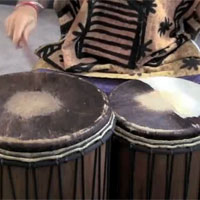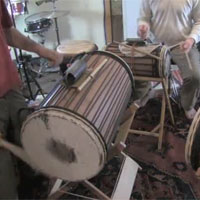What is the difference between playing ballet style dunun drums and traditional style dunun playing? Traditional is sideways played by three or two players and Ballet stye the dunun are played standing up. But it goes beyond this.
The dunun are a set of three double sided drums hit with sticks that

make up the heart, melody and soul of traditional West African djembe music. Their importance is often misunderstood or underated.
Every djembe piece from West Africa has different dunun parts. Often the djembe parts remain the same or similar (“djembe passport”parts), but the dunun parts are always different.
Some people call them Djun Djun, but I am not sure why as Djun Djun is the name of the Nigerian talking drum. Some people also call them Djuns or Duns. I am not here to correct anon, just to share.
The dunun create the melody and feel and the djembe come second in importance in the musical arrangements in traditional drumming in the village in most cases (excluding places where they don’t have dunun of course).

If you were to think of a western rock band you have a bass player , keyboard player, rhythm guitar, etc. Together they make the rhythm and melody section. Its the same on the dunun.
The dunun are traditionally (i.e. in the villages/countryside) played sideways or horizontally either directly on the ground, worn on the body, played on a stand or any combination there of.
One player will play one drum each and usually each drum has a bell on top of it struck with a dinger (stick like object) or a ring. In Mali the bell is held in the air and it is struck with a ring on the thumb of the hand holding the bell.

Playing the dunun horizontally is not a traditional form of playing. It is a modern creation that is practical as well as functional for various reasons.
Please note, I am not saying it is better then the traditional style. As a matter of fact I think it is necessary and more important to learn to play each individual drum in the dunun family in the traditional style and way as well or even prior to learning the ballet style.
The ballet style of playing the dunun was created in the city in and for ballets and performing groups in Guinea, Mali and Senegal as a way to modernize the music arrangements and for stage performances.
The desire of the music arranger or arranger of the dunun parts was to make the music faster, to be more creative and to be more exciting for an uneducated audience.
One player playing all three parts can play the rhythms faster, with more flash and therefore be considered “more exciting”. I am not saying it is, I am saying that was the desired effect. The dunun player can play rolls, jump over the drums, etc., etc.

Many people see the ballet style being played in dance classes or events in the the USA and outside of West Africa and don’t realize that this is not a traditional style. However, if you don’t have three people trained to play traditional style dunun then one person playing three drums is the next best thing.
And also if you are playing by yourself it is a way to play all three parts with out having other people around. Playing this styles leads out certain parts. It is a compromise as we can not possibly replicate the feel and all the accents and flavour that happens when 2 or 3 other individuals are each playing a kinking, sang ban and dununba, the high, middle and low drums of the dunun ensemble.

In Mali the kinkini is called konkoni. interestingly enough there seems to be four different meanings for the word dununba.
For example, the Dununba is a party or community celebration. “We are having a dununba”. It is the lowest drum of the three in a set of dunun. It is also the name of a family of rhythms originating allegedly in Hamanah region of Guinea where one of my favourite teachers, Namory Keita is from.
Some people also call the set of 3 drums dununba (instead of dunun) but I do not know if this is correct or not.

So, if you do not have two or three players to play each dununba part then you may want to learn to play ballet style and it may be a very practical system for you.
Because it is not set or traditional there are many many different ways to play each rhythm that originated from the tradition. It really depends on who you are playing for and what they want to hear. Or perhaps what you want to hear?
In my experience i have found that often a dance teacher or dance performer will have a specific version of a ballet piece they will want to hear on the dunun and it may be different then how your teacher showed you how to play it. So you need to be flexible and learn as many different styles as is comfortable.
I am very happy to see and hear the west african rhythms I have been studying now being played by many of my students in drum circles. The ballet style is a perfect way to integrate and fuse with drum circle players, groups and at drum circles and drum jams. They fit in perfectly and help to educate others who may have no clue that these rhythms, structures or cultures they come from even exist.
I have put together a downloadable lesson series of four “Essential Ballet Style Dunun Rhythms” lessons. Volume #1, the first in the series has the first 16 rhythms I am sharing. You can go to the lessons section right here on this website to order.

I play each rhythm a few different ways, on two drums and three drums when possible. You choose which style you want to learn or learn them all. Most of them I show with a bell option or no bell.
I play the rhythms at moderate and very slow speeds and use breakdowns when necessary.
There are also a few slow motion sequences for parts I feel need to be seen very slowly to understand. I list the countries of origin in the headers before each video as well.
These are some my favourite particular rhythms I have studied over many years with many different teachers and represent a wide body of material from numerous places. I hope you enjoy watching and learning them as much as I did making this video.
I am including a demo link here. Just click on this: http://youtu.be/uO5RvVb4RF8
This is a preview or demo. It is not the actual class. It is an example of the lesson. The lesson sequences are much longer. Also parts are played slower. This is just posted so that you can have an idea whats in the video. And, as always I am open to and welcome your positive feedback and suggestions.

